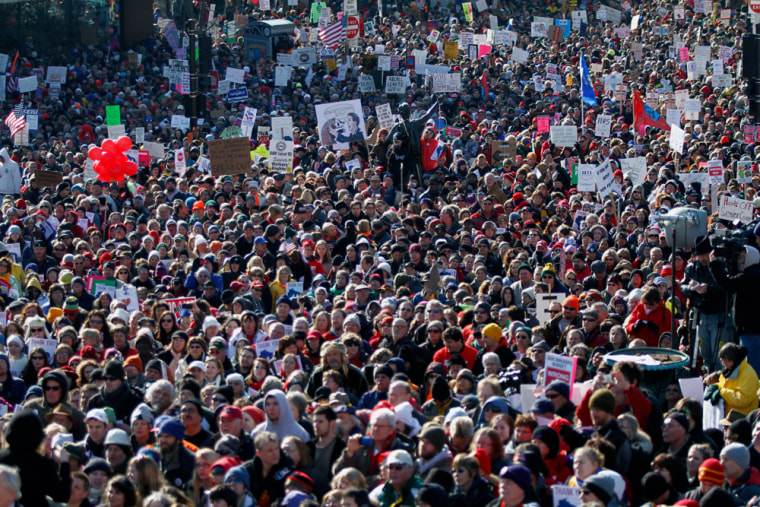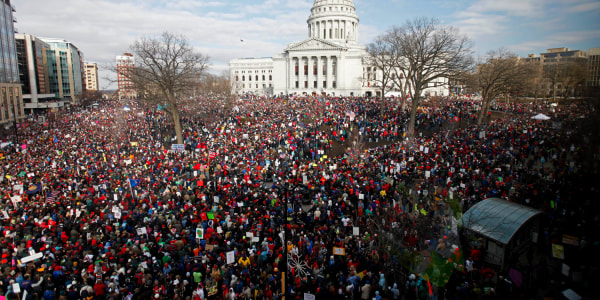Organized labor was once so powerful that President Franklin Roosevelt told his party’s national chairman to “Clear it with Sidney” — labor leader Sidney Hillman — before announcing Harry Truman as FDR's running mate at the 1944 Democratic convention.
Labor remains a potent force nearly 70 years later.
In the 2008 elections, three major unions, representing public school teachers, government workers, and service workers, contributed more than $100 million to candidates for federal and state office, with most of it being spent on state races and almost all of it for Democrats.
This figure does not include the millions of dollars unions spent on contacting members to get them to vote, conducting phone-banking for candidates, and completing other important campaign chores.
But the law Wisconsin Gov. Scott Walker signed Friday, which curtails unions’ power to bargain and to collect union dues, may be a turning point in labor’s political role.
Here are questions that unions face in the wake of the Wisconsin law:
Are other Republican legislatures and governors being inspired by the outcome in Wisconsin to try to impose limits on collective bargaining for public sector workers? Or will Walker’s dismal poll numbers deter them?
“I think GOP governors could be inspired by the outcome in Wisconsin, but also be very wary and aware that setting the tone of the debate is critical,” said Saul Anuzis, a veteran Republican consultant and former chairman of the Michigan Republican Party.
In Ohio, Republican Gov. John Kasich is supporting a bill, passed two weeks ago by the state Senate, to curb public employee unions’ power, although it doesn’t go as far as the Wisconsin law, according to University of Akron political scientist John Green.
“Ohio Republicans are certainly mindful of the situation in Wisconsin. My sense is that Republicans will handle this issue with care and may pursue it in a more moderate form.”
Green said the Ohio bill “was more moderate than the Wisconsin bill from the beginning, was amended in the state Senate and may be amended again in the state House. Such efforts could reduce somewhat the level of public criticism. But Ohio Republicans still see virtue in the effort and are expecting considerable opposition from labor and their allies.”
In Iowa last week, the Republican-majority state assembly passed a bill to allow public employees to become “free agent employees” by rejecting representation by a union.
The bill also would change the rules on binding arbitration in disputes between public employee unions and state and local governments by allowing an arbitrator to impose a settlement different from what either labor or management had offered. Unions have lobbied against the bill while the National Federation of Independent Business and the Iowa Association of Business and Industry have lobbied for it.
The legislation would “dramatically change the balance of power” and “dramatically change the bargaining process in the state,” said State Senate Democratic Leader Mike Gronstal. He added “it’s exceedingly unlikely” that the bill will be debated or voted on in the state Senate where the Democrats have a majority.
Slideshow 68 photos
The battle over collective bargaining rights in Wisconsin
Meanwhile in Michigan, the Republican-controlled legislature is poised to enact a bill supported by the new Republican governor, Rick Snyder, that would expand the state’s power over fiscally distressed local governments and give emergency financial managers the power to end contracts with government employee unions. “That’s another bill that would have a tremendous impact on public sector workers” said Naomi Walker, director of state government relations for the AFL-CIO labor confederation.
Will new limits on collective bargaining in Wisconsin (and possibly in other states) deter employees from choosing to join a public employee union?
At first glance, if a union is going to be less able to win the wage and benefit demands it seeks, then a worker would have less incentive to join the union.
“It could be a deterrent to recruiting high quality employees,” said Green. “The issue is less collective bargaining than the results of collective bargaining, namely wages, benefits, and working conditions. If these things decline substantially, it may be harder to recruit high quality government workers.”
Eileen Norcross, a state and local government analyst at the Mercatus Center at George Mason University, says the power to use collective bargaining is an important factor, but not the only reason why unions have been able to get what they wanted from state and local governments.
Strong collective bargaining rights tend to go hand in hand with politically active unions and pro-union public sentiment.
In such places, Norcross said, public sector unions "can elect their own bosses and those who control the budget. The incentives of the public sector union and politicians are often aligned, much more so than in the private sector."
Until recently Wisconsin was assumed to be such a place, which is one reason why Walker's success in enacting his union curbs has caused political shock waves.
To what extent will the unions’ treasuries suffer from laws such as the one enacted in Wisconsin and to what extent will this limit union political activities?
Overlooked in the furor over collective bargaining are the provisions in the new Wisconsin law prohibiting municipal or state employers from deducting labor union dues from the earnings of most employees. The law also gives most municipal and state employees the right to opt out of paying union dues even while being represented by a union in bargaining over wages.
These provisions may starve the unions of money that could be used in political campaigns.
“It will have an impact on workers’ ability to have a voice in politics and in legislation,” said the AFL-CIO's Naomi Walker.
Union expert Marick Masters, the director ofthe Labor Studies Center at Wayne State University in Detroit, said the provisions “would substantially reduce the money that the unions have available in Wisconsin for political activity.” He added, “This is about more than collective bargaining; it is about tipping the scales of political power.”
“In the long run, a decline in public sector unions could change the balance of power in American politics by diminishing a major constituency of the Democratic Party,” Green said. “However, this is not likely to happen overnight.”
Anuzis said,“Union bosses will have to be more careful with their political funds and possibly be more reflective of their members by becoming more bipartisan. This will not cause a significant change in the balance of power, but will clearly affect the way unions play in politics.”
But Democrats argue that Walker’s law will backfire. Gronstal said “the Republicans have made a colossal misjudgment on this … The Republicans are massively overplaying their hand.” And Gronstal and other Democrats say Walker is “awakening the sleeping giant” of previously unconcerned people flocking to the union cause.
If the “sleeping giant” theory is accurate, the effect should be visible not only in the recall efforts underway against 16 Wisconsin lawmakers (eight from each party), but in special elections on May 3 in three vacant Wisconsin assembly seats, all of which were held by Republicans until early this year.
In the 2012 elections, if an invigorated pro-labor vote showed up, it could be crucial in Wisconsin and Ohio, both of which are likely to be hotly contested states. President Obama carried both states in 2008, but in 2004 President George W. Bush won Ohio and got 48 percent of the vote in Wisconsin.
What is the forecast for public sector employment and for public employee unions?
Labor union membership as a percentage of the total U.S. workforce peaked at 25 percent in the late 1950s and has been falling ever since. Last year only 11.9 percent of American workers belonged to unions.
But until recently, government employee union membership had been growing, both in absolute numbers and as percentage of the public employee workforce.
The union membership rate for public sector workers in 2010 was 36.2 percent, compared to only 6.9 percent for private sector workers, with 7.6 million public sector employees belonging to a union, compared to 7.1 million union workers in the private sector.
But the growth period has likely ended. According to the Bureau of Labor Statistics, the number of state employees hit its all-time peak in January 2009 at 5.2 million and has declined by about 1.6 percent since then. The number of local government workers peaked at 14.6 million in September of 2008 and has declined by about 2.6 percent since then.
“With the projected budget deficits that states have now and into the future, and with the anemic economic growth we have, it’s very unlikely that you’re going to see anything but continuing reductions at the state and local level,” Masters said.
The public sector unions are fighting for a share of a pie that’s growing smaller.

